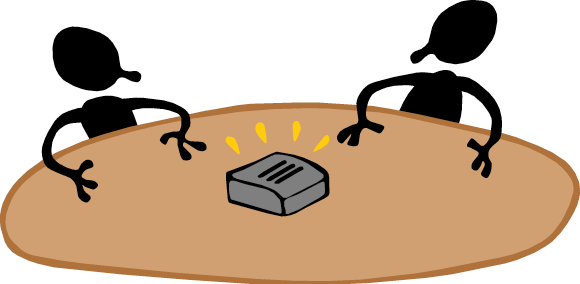Amazingly, talented people who care can come together and yet fail demonstrably in a ‘meeting.’
Meetings fail because the participants do not know HOW TO succeed. Meeting challenges include anything that takes the energy from meetings. To deal with low energy, first understand the causes of meeting challenges.
Chaos Without Structure
To contend with difficulties, take a closer look at how a normal business meeting processes information. Like all other forms of energy, unless you harness and manage meetings within a structured environment, chaos will result. The structure takes the creative energy generated in a group and converts it into something productive. The creative energy available to any group comes as ideas and information. When information and ideas are processed in business meetings, it is usually done without adequate structure.
Information Problems

Meeting Challenges
The following information processing problems occur because of unstructured meetings:
- Disruptive interruptus—limits the continuity of the group’s ideas.
- Inconclusive progressions—moving on to another topic and not adequately concluding or summarizing the previous topic.
- Information queuing—mentally storing comments while waiting for an opportunity to speak. When the time comes, the timing is inappropriate and the discussion gets derailed.
- Mixing abstractions—two people talking at different perspectives and levels of detail, different wavelengths, or different levels of resolution.
- Solution jumping—prematurely discussing solutions before the problem has been adequately defined.
- Topic jumping—inappropriately changing the topic. (In the average unstructured meeting, groups change topics every minute and a half.)
Complicating Factors
Complicating even further are the tactics used by meeting leaders to deal with information-processing problems. Three common and unsuccessful approaches:
- Heavy-handed control—overreaction that results in the inhibition of creativity and analysis.
- Symposium style—speaking one at a time in sequence. Eliminates the advantage of spontaneous interaction.
- Withdrawal—results in no direction at all.
Decision Problems
Decisions are made generally by:
- Default (that’s the way they wanted it anyway)
- Dominance (the squeaky wheel syndrome)
- Groupthink (no one disagrees or questions the decision because all assume someone—usually a strong leader—has the right answer. This is one of the explanations for the “Bay of Pigs” incident—no one argued with the decision).
- Sheer exhaustion (we give up—do what you want)
Decision Styles
In response to the problems of decision-making, some leaders have adopted tactics such as:
- Authoritarian (good control and quick, but is often wrong and creates low morale)
- Consensus (encourages participation/ unanimity, but is slow without someone to facilitate it through discipline and structure)
- Majority rules (very democratic and participative, but allows tyranny of the majority and is slow)
- Minority rules (permits persuasion, but creates political resentment)
Underdevelopment
Remember, while the number of meetings is growing, the mismanagement of meetings is costing a substantial amount of money each year. Wasted time equals wasted resources. Meeting leadership is an underdeveloped management skill, but it can be learned.
Meeting Types
There are as many types of meetings as there are meeting leaders. Most meetings, however, fall into three general categories:
- Information sharing meetings
- Task-related meetings—directed or instructional
- Task-related meetings—facilitated or developed
Loss of Creative Energy
Session leaders typically use more than 60 percent of the communication time available in a meeting, leaving at most 40 percent of the talk time for participants, or 24 minutes in a one-hour meeting. Unequal distribution means much of the creative energy located within the group is not being tapped, decreasing the productivity of the meeting. Hence, it’s no wonder meetings fail because of low energy.
______
Don’t ruin your career by hosting bad meetings. Sign up for a workshop or send this to someone who should. MGRUSH workshops focus on meeting design and practice. Each person practices tools, methods, and activities every day during the week. Therefore, while some call this immersion, we call it the road to building high-value facilitation skills.
Our workshops also provide a superb way to earn up to 40 SEUs from the Scrum Alliance, 40 CDUs from IIBA, 40 Continuous Learning Points (CLPs) based on Federal Acquisition Certification Continuous Professional Learning Requirements using Training and Education activities, 40 Professional Development Units (PDUs) from SAVE International, as well as 4.0 CEUs for other professions. (See workshop and Reference Manual descriptions for details.)
Want a free 10-minute break timer? Sign up for our once-monthly newsletter HERE and receive a timer along with four other of our favorite facilitation tools, free.
Related articles
- 3 Ways to Keep Meetings Short (Every Time) (inc.com)
- How to Design Culture: 16 Patterns to Build Adaptive Learning Organizations (emergentbydesign.com)

Terrence Metz, president of MG RUSH Facilitation Training, was just 22-years-old and working as a Sales Engineer at Honeywell when he recognized a widespread problem—most meetings were ineffective and poorly led, wasting both time and company resources. However, he also observed meetings that worked. What set them apart? A well-prepared leader who structured the session to ensure participants contributed meaningfully and achieved clear outcomes.
Throughout his career, Metz, who earned an MBA from Kellogg (Northwestern University) experienced and also trained in various facilitation techniques. In 2004, he purchased MG RUSH where he shifted his focus toward improving established meeting designs and building a curriculum that would teach others how to lead, facilitate, and structure meetings that drive results. His expertise in training world-class facilitators led to the 2020 publication of Meetings That Get Results: A Guide to Building Better Meetings, a comprehensive resource on effectively building consensus.
Grounded in the principle that “nobody is smarter than everybody,” the book details the why, what, and how of building consensus when making decisions, planning, and solving problems. Along with a Participant’s Guide and supplemental workshops, it supports learning from foundational awareness to professional certification.
Metz’s first book, Change or Die: A Business Process Improvement Manual, tackled the challenges of process optimization. His upcoming book, Catalyst: Facilitating Innovation, focuses on meetings and workshops that don’t simply end when time runs out but conclude with actionable next steps and clear assignments—ensuring progress beyond discussions and ideas.



